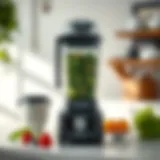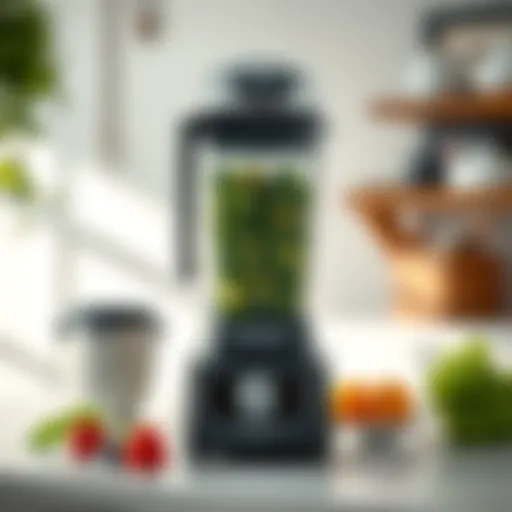Choosing the Perfect Gray for Your Kitchen Cabinets
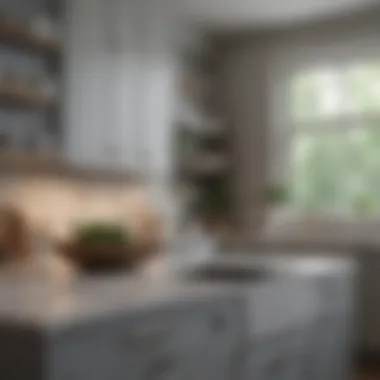

Intro
Choosing the right gray for kitchen cabinets can feel like navigating a maze. It’s not just about picking a color, but about finding a hue that echoes your style while also standing up to the everyday hustle of a kitchen. Gray is more than a neutral; it’s a versatile backdrop that can make your space feel modern and inviting. In this exploration, we’ll dissect various gray shades, align them with current trends, and consider practical tips for maintenance. If you’re ready to give your kitchen a sophisticated touch, you're in the right place.
Design Inspirations
When embarking on the journey of selecting gray for kitchen cabinets, it's essential to draw inspiration from design styles that resonate with you. Gray doesn’t have to be boring, and with the right approach, it can transform your kitchen into a stylish hub.
Trending Styles
As we glance at the current trends, a few standout styles can help guide your choice of gray.
- Modern Minimalism: Clean lines, open spaces, and subtle shades of gray accentuate this look. Think light grays or soft charcoal that create a sleek, uncluttered aesthetic.
- Industrial Edge: If you're drawn to the raw charm of industrial design, consider darker grays paired with metal accents. This combination delivers an urban vibe that's both chic and functional.
- Farmhouse Appeal: Soft, muted gray tones can instill a warm and cozy vibe. Pair these with natural wood finishes for that perfect farmhouse balance that feels welcoming and homely.
Regardless of your chosen style, ensure that the gray you pick aligns with the overall theme and mood you want to create.
Color Palettes
Next, let’s explore color palettes that work harmoniously with gray kitchen cabinets.
- Gray and White: A classic combination, this palette offers a clean and airy feel. White countertops can brighten up darker gray cabinets, providing a balanced contrast.
- Gray and Navy: For those looking to make a statement, navy blue paired with gray creates a sophisticated and timeless aesthetic. This duo works well in both modern and traditional settings.
- Gray and Earth Tones: Incorporating earthy colors like greens and browns can ground your space, adding warmth to the cooler gray. Consider selecting a sage green or soft beige for a complementary effect.
Remember, choosing the right colors alongside your gray cabinets can elevate your kitchen’s ambiance.
"The right shade of gray is like a chameleon, adjusting to the light and surrounding hues, enhancing your kitchen's charm."
By reflecting on these inspirations, you can envision how gray can fit into your kitchen design while echoing your personal taste. Transitioning from dreams to reality involves not just picking the right color, but understanding its context within your broader space.
Understanding Gray in Design
Color is more than just a visual element; it influences emotions, perceptions, and even motivations. Gray, often overlooked, holds a powerful role in design, particularly in spaces like kitchens where harmony and functionality intersect. This section lays the groundwork for understanding why gray is not merely a shade but a pivotal choice in crafting your kitchen’s ambiance.
The Psychological Impact of Gray
Gray is often seen as a balanced and calming color. It sits comfortably between black and white, represented by neutrality and sophistication. This balance can evoke a sense of peace and tranquility, creating an inviting kitchen environment where family and friends can gather without distraction. An interesting aspect of gray is its versatility in creating atmosphere.
- Variations of gray can influence moods differently. Light grays often imbue a space with airiness and warmth while darker grays can anchor a room, offering grounding elements.
- Psychology also shows that gray reduces the stimulation caused by more vibrant colors, making it an ideal backdrop for kitchens that aim for subtle elegance without becoming boring.
"Color is the keyboard, the eyes are the harmonies, the soul is the piano with many strings."
– Wassily Kandinsky
Thus, choosing the right shade of gray can greatly affect the mood of your kitchen, making it either a warm haven or a sleek modern hub, depending on the hue.
Gray as a Neutral Base
When considering the aesthetics of a kitchen, gray is often chosen as a base color. Why? It effectively complements a wide array of colors, styles, and textures. Think of gray as a chameleon. Its adaptability allows it to blend seamlessly with other hues, whether you're considering vibrant accessories or additional fixtures.
Some benefits of employing gray as your go-to neutral include:
- Versatility: Works beautifully with whites, blacks, woods, and even bold hues.
- Timelessness: Gray has a classic appeal that remains stylish across design trends. Unlike fads, which can fade faster than a pop song, gray maintains its charm.
- Ease of Integration: Gray seamlessly fits into both modern and traditional aesthetics. This means, if you fancy an eclectic mix of styles, gray can serve as a consistent foundation.
Incorporating gray as a primary backdrop also invites the opportunity to highlight design elements without overshadowing them. The cabinets, countertops, and even the decorative accessories can shine against the understated yet chic narrative that gray creates. By understanding gray as an influential player in your design strategy, you place your kitchen steps ahead in achieving a well-rounded aesthetic that is both functional and beautiful.
The Aesthetics of Gray Kitchen Cabinets
When it comes to kitchen design, the aesthetic appeal often becomes a paramount consideration. Gray kitchen cabinets have gained considerable traction, drawing homeowners and design enthusiasts alike. Their adaptability allows them to fit seamlessly into various design styles, from modern minimalism to rustic charm. The nuanced language of gray—from soft whispers of light gray to the bold statements of charcoal—allows for a myriad of expressions, making them a wise and stylish choice.
Combining Gray with Other Colors
Through the interplay of gray with other hues, the artistry of a kitchen comes alive. Here we’ll dive into how different colors can enhance the beauty of gray cabinets and, in turn, create a cohesive look for the kitchen.
White
White has an airy quality that elevates the feel of any space. When paired with gray, it can create a striking contrast without being overly jarring. This color combination can evoke feelings of cleanliness and spaciousness, making it particularly appealing for smaller kitchens. As a benefit, white cabinetry or accents can reflect natural light, thus brightening the area considerably. However, one should be cautious, as too much white can sometimes create a sterile environment, especially in kitchens that lack natural light.
Black
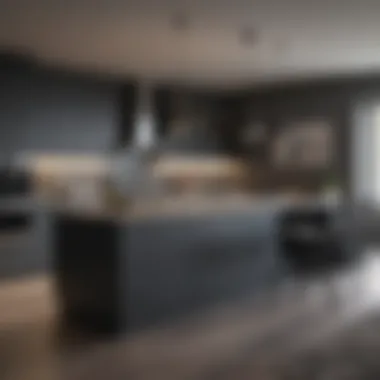

On the opposite side of the spectrum, black serves as a bold companion to gray. This pairing introduces a touch of sophistication and modernity that can transform a simple kitchen into an exquisite space. Black elements like countertops or hardware can ground the design while allowing the gray to maintain its subtlety. The downside? Black can absorb light, which might make a small kitchen feel more confined. Balancing this with adequate lighting becomes crucial to not lose the openness that gray aims to provide.
Wood tones
Incorporating wood tones brings an earthy feel to the palette. The warmth of natural wood can soften the starkness of gray, fostering a welcoming ambiance in the kitchen. Whether it's warm oak or rich walnut, wood tones add a touch of nature and texture that gray alone may not convey. This blend often leads to a timeless look—one that feels both modern and nostalgic at the same time. However, the challenge is ensuring that the wood tones don’t clash with the chosen shade of gray. Finding the right balance can sometimes require a bit of trial and error.
Bold colors
For those willing to step outside the box, pairing gray with bold colors can create a striking focal point. Colors such as deep navy, vibrant red, or rich emerald introduce energy into the kitchen. These vibrant tones can serve as accents against a backdrop of gray, immediately grabbing attention. The advantage of such bold choices is that they allow for personal expression and creativity. On the downside, the risk is a disharmonious clash if not executed properly. Ensuring the bold colors complement rather than compete with gray is key to maintaining a balanced aesthetic.
Shades of Gray: Warm vs. Cool
Gray isn’t a one-size-fits-all shade; it has a spectrum of tones that can lean warm or cool, influencing the overall vibe of the kitchen. Warmer grays, often infused with hints of beige or brown, can impart a cozy, inviting atmosphere. This is particularly advantageous in kitchens designed for family gatherings or entertaining.
Conversely, cool gray shades can bring an element of sleek sophistication, ideally suited for contemporary or industrial designs. These tones tend to reflect a clean and crisp aesthetic, making them popular choices in modern kitchens. The important takeaway is that the chosen shade of gray deeply affects not only the look of the cabinets but the feel of the entire space, guiding the emotional response to your kitchen design.
"The beauty of gray lies in its versatility. From warm to cool shades, it has the ability to accommodate various color palettes and personal styles."
In essence, when selecting gray for kitchen cabinets, one must consider not just the shade but also how it interacts with other colors and elements in the kitchen. The aim here is to create a cohesive and aesthetically pleasing environment that aligns with personal style and the ambiance desired.
Factors Influencing Gray Selection
Choosing the right gray for your kitchen cabinets isn't just about what looks pretty; there are several elements that play a significant role in making the best decision. Grays are often seen as a versatile color, but it's important to consider factors such as kitchen size, lighting, and existing design elements. These factors affect how the color is perceived and how it can affect the overall atmosphere of the kitchen.
The right gray can create a soothing and elegant space, but without proper consideration, you risk a mismatched look that could detract from your home’s appeal. With that in mind, let’s explore each contributing factor in detail.
Kitchen Size and Lighting
Natural light considerations
Natural light can truly be the best ally when selecting a gray for your cabinets. The amount and quality of sunlight in your kitchen can vastly change how a gray appears. For example, a gray that looks warm in direct sunlight could appear quite cool in dimmer conditions. Keeping this in mind, it’s essential to observe different shades at various times of the day in your kitchen. This observation helps in finding the right fit for the ambiance you wish to create.
- The key characteristic of natural light is its dynamic nature. It shifts and changes throughout the day, illuminating and casting shadows, which can alter your perception of the color.
- That’s why experimenting with samples on swatches is a beneficial approach before making the final decision on your cabinets. It allows you to understand how that color interacts with the natural light in your space.
A unique feature of natural light is its ability to highlight intricacies within shades of gray, giving depth to the color. Such variations can add an exquisite touch to your kitchen but can also lead to unexpected results if not tested prior.
Artificial lighting effects
Artificial lighting can also play a game-changing role in the pursuit of the perfect gray. Unlike natural light, which can fluctuate, artificial lighting remains consistent, yet it can introduce a different vibe based on its type – be it warm white, cool white, or LED. The shade of gray you select may look entirely different under various kinds of artificial lights.
- A key characteristic of artificial lighting is that it can create a very controlled environment, allowing you to see how colors will appear when you are preparing meals or entertaining guests.
- This aspect is often cited as a benefit because it allows for a more predictable outcome, but be mindful; there is also a downside. Some grays can feel overly cold or stark under certain artificial lighting, especially flourescent lights.
One unique feature of this lighting approach is that it allows for a planned look, letting you choose your color with a clear understanding of how it will translate in the installed environment. Pay attention to how each light source accentuates or mutes the chosen gray.
Existing Design Elements
While the gray of kitchen cabinets stands out, it doesn’t exist in isolation. Existing design elements such as countertops, backsplashes, and flooring can dramatically influence your choice. They serve as complementary textures and hues that can either enhance or clash with your desired gray.
Countertops
Countertops often serve as the focal point of a kitchen. Choosing the right countertop material and color can enhance the look of gray cabinets. For instance, a white marble countertop with gray veining can create an elegant, cohesive feel when paired with a light gray cabinet.
- The key characteristic of countertops is their durability; they are often the hardest working surface in the kitchen.
- Keeping in mind that they need to withstand wear and tear, selecting a color that harmonizes with gray can lead to a pleasing aesthetic and through that, a beneficial cooking and entertaining space.
A unique feature of countertops is that they can offer a tactile contrast to the smoothness of painted cabinets. If you select a robust surface, it can play an important role in balancing subtle shades of gray.
Backsplash
A well-considered backsplash can be a game-changer for your kitchen's overall design. It can elevate the look of your gray cabinets, emphasizing certain tones in the selected gray or contrasting them.
- One key characteristic of backsplashes is their ability to serve as a design statement. Think glass tiles, subway tiles, or even natural stone – all can enhance your cabinet choice.
- Selecting a backsplash that complements the gray can create a seamless transition across the room which proves to be a popular design choice.
The unique feature of a backsplash is its flexibility; it typically features a wide array of colors and designs. This allows homeowners to showcase personal style while complementing gray tones.
Flooring
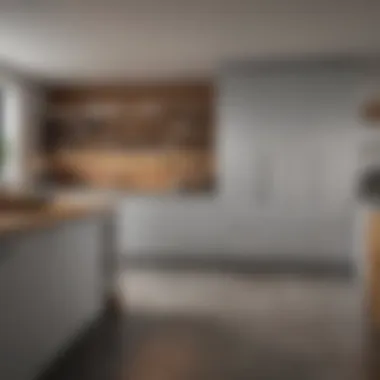

Flooring is another design aspect that should not be overlooked when choosing gray for kitchen cabinets. The tone of your floor—be it dark wood, light laminate, or even tiles—can deeply impact how the gray is perceived.
- The key characteristic of flooring is its impact on the overall mood of a space. Darker floors often ground a kitchen, while lighter flooring can make a room feel larger.
- The right floor can not only accentuate gray cabinets but also tie the entire kitchen design together, making it a beneficial asset to consider.
One unique feature of flooring is its ability to affect foot traffic patterns and practical usability in the kitchen. When you choose flooring that complements your gray cabinetry, it often enhances the visual appeal without sacrificing functionality.
Understanding how these elements interact will better prepare you to select the ideal gray for your kitchen cabinets, ensuring they fit seamlessly into your overall design.
Popular Gray Shades for Kitchen Cabinets
Selecting the perfect gray hue for kitchen cabinets can truly set the tone and aesthetic of the space. Gray is often seen as a versatile neutral, allowing homeowners to experiment with various styles and colors in their kitchens. The shades discussed here—charcoal gray, slate gray, and light gray—each hold unique characteristics that can create distinct atmospheres and visual appeal. Choosing the right gray not only enhances the cabinetry but also harmonizes with other design elements within the kitchen. Here, we dive into these popular gray shades to help you make an informed decision.
Charcoal Gray
Charcoal gray is a bold choice, characterized by its deep, rich tone. It adds a strong presence to kitchen cabinets, lending an air of sophistication and elegance. This shade works wonders in modern designs, especially when paired with white, stainless steel, or even wood accents. One practical aspect of charcoal gray is its ability to hide dirt and stains, making it suitable for busy kitchens.
"Charcoal gray provides depth while maintaining a sleek appearance, making it a favorite among those who desire a contemporary look."
When considering charcoal gray, think about how it will interact with the lighting in your kitchen. In spaces with abundant natural light, this color may soften and reveal its warmer undertones. On the flip side, in dimmer settings, charcoal can appear even darker, perhaps bordering on black. It's essential to test paint samples in different lighting before making a final call.
Slate Gray
Slate gray strikes a fine balance between light and dark, giving a stylish yet approachable feel to kitchen cabinets. This shade embodies a refined elegance and complements a myriad of styles, from industrial to traditional. Pairing slate gray with cool-toned elements results in a sleek, modern vibe, while warm accents can lend a more rustic charm to the overall design.
When selecting slate gray, consider its adaptability. It pairs exceptionally well with white and pale creams, creating a soft contrast that enhances the kitchen’s brightness. Slate gray also complements blues and greens, making it an excellent choice for highlighting personal touches in decor. This shade has a friendly warmth that won’t overpower the space, making it appealing to many homeowners.
Light Gray
Light gray embodies a fresh and airy aesthetic, perfect for kitchens that aim to feel open and bright. This shade reflects light well, making even smaller spaces feel larger. Because of its subtlety, light gray serves as an excellent backdrop for highlighting more colorful elements, such as vibrant backsplash tiles or decorative accessories.
Using light gray in the kitchen provides flexibility. It can effortlessly adapt to current trends, complementing either contemporary or more classic designs. Furthermore, light gray cabinetry feels inviting and cheerful without being overwhelming. Keep in mind that stain resistance and wear can be a concern, as lighter shades tend to show marks more easily than their darker counterparts. Regular upkeep and careful material selection can balance these concerns effectively.
Selecting the right gray shade for kitchen cabinets can substantially impact the overall aesthetic and feel of this essential space in the home. Whether opting for the deep elegance of charcoal, the balanced charm of slate, or the airy lift of light gray, each comes with its own set of benefits and design opportunities. As always, thorough consideration of your kitchen's unique characteristics will allow for a successful integration of these shades into your design.
Finishing Techniques for Gray Cabinets
When selecting gray for kitchen cabinets, one cannot overlook the importance of finishing techniques. The finish can significantly alter the appearance and durability of the cabinets. Thus, choosing the right finish is a vital step in ensuring a cohesive and inviting kitchen look.
First, finishes can enhance or mute the character of the gray hue. For instance, the same shade of gray can appear entirely different depending on whether it’s applied with a matte, glossy, or textured finish. It's essential to align the finish with the overall design intention of the kitchen. If you want sophistication with an understated vibe, matte finishes might be your go-to. Conversely, if brightness and vibrancy are the goals, gloss finishes could work wonders.
Matte vs. Glossy Finishes
Matte finishes are subtle, offering a soft, non-reflective appearance. This makes them particularly appealing in contemporary and rustic kitchens where the aim is to exude a calm and elegant feel. One plus side of using matte finishes on gray cabinets is that they tend to hide fingerprints, dust, and scratches more effectively than other finishes. There is something undeniably modern about the understated look of a matte cabinet that resonates with many homeowners today.
On the flip side, glossy finishes boast a reflective quality that brings out the sleekness of gray. Glossy cabinets naturally brighten a space by bouncing light around, potentially making smaller kitchens feel more open. However, it’s worth noting that they may require more frequent cleaning due to visible smudges and streaks.
In addition, gloss can accentuate the hues such as taupe or sage that might be mixed in with gray, adding depth to your cabinet’s appearance. Each finish, matte or glossy, offers distinct advantages:
- Matte Finishes:
- Glossy Finishes:
- Reduced visibility of fingerprints and smudges.
- Achieves a modern, understated aesthetic.
- Easier to match with other matte elements in the kitchen.
- Adds brightness and warmth to the kitchen space.
- Hightens color depth in gray shades.
- Reflects light well, creating an illusion of more space.
Selecting between matte and glossy often boils down to personal preference and lifestyle considerations.
Textured Finishes
Textured finishes introduce another layer of complexity to gray cabinets, allowing for a unique aesthetic that engages both sight and touch. A textured surface can bring warmth and depth to otherwise flat gray tones. Popular textures include beadboard, rough-sawn wood, or even a subtle, sand-like finish.
By adding texture, one can play with shadows and light, resulting in a dimensional look that’s far from ordinary. Textured finishes can be especially advantageous in traditional or farmhouse-style kitchens, where a cozy, inviting atmosphere is desired. They also tend to create visual interest, drawing attention to the cabinetry as the highlight of the kitchen.
Furthermore, choosing a textured finish can help hide any imperfections or wear that may develop over time. When you think about longevity, textured finishes might come out ahead as contending with the nicks and scratches that are natural in a busy kitchen environment can be less noticeable.
In summary, the finishing technique chosen plays a pivotal role in how gray cabinets will be perceived and performed in a kitchen. Understanding the nuances of matte vs. glossy, along with the added dynamics that texture provides, equips homeowners and design enthusiasts alike with the knowledge to make an informed choice in their quest for the ideal kitchen ambiance.
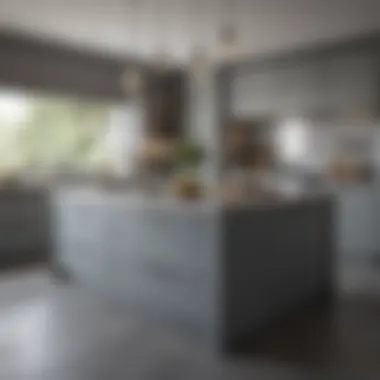

Integration of Gray Cabinets in Modern Kitchens
Gray cabinets have, without a doubt, carved a niche in modern kitchen design. Their versatility and understated elegance fit seamlessly into various styles, providing a solid foundation for creative expression. When considering the integration of gray cabinets, it’s important to recognize their potential impact on the overall design of a kitchen. Whether you’re looking for a sleek and minimalist appearance or something with a more industrial flair, gray can adapt to your needs.
One of the foremost benefits of gray cabinets is their neutrality. They can accommodate a wide range of colors—from rich jewel tones to subtle pastels—allowing homeowners to inject their personal style without overwhelming the space. In addition, gray has the practical benefit of better hiding scratches and stains compared to lighter shades, keeping the kitchen looking fresh even after years of use.
Minimalist Approaches
In a world often bustling with visual clutter, the minimalist style advocates simplicity and functionality. Gray cabinets play a pivotal role in achieving this aesthetic. Opting for a warm or cool gray tone helps in creating an inviting atmosphere while maintaining a sense of calm.
For instance, using a soft gray paired with white countertops can open up the space, making even the smallest kitchens feel airy. The simplicity of flat-panel cabinets with clean lines resonates well with the minimalist philosophy. When combined with natural wood accents or metal handles, gray cabinets can easily elevate a space, adding a touch of sophistication without being showy.
Here are some elements to consider when adopting a minimalist approach with gray cabinets:
- Decluttered Spaces: Stow away kitchen gadgets and display only the essentials.
- Uniformity: Choose a consistent gray shade across the cabinets to maintain visual harmony.
- Natural Light: Make the most of natural light to enhance the beauty of gray; it changes tone throughout the day.
Industrial Styles
Industrial design often borders on the raw and unfinished. In this realm, gray cabinets are an ideal match. Their robust and practical nature pairs well with the rugged appeal synonymous with industrial spaces. Think of a kitchen with exposed brick, reclaimed wood, and steel elements—gray cabinets can tie the look together flawlessly.
For this style, consider:
- Rich Charcoal or Slate Shades: These deeper hues add drama and enhance the industrial vibe.
- Textured Finishes: A distressed or matte finish can add an authentic touch, evoking the feeling of vintage warehouses.
- Mixing Materials: Pair gray with black metal fixtures or wooden countertops for a balanced look that pays homage to industrial heritage.
"Gray cabinets can serve as the backbone of a kitchen design, allowing for versatility and creativity to shine."
Integrating gray cabinets within modern kitchens offers practical and aesthetic benefits. By understanding how to utilize gray in minimalist and industrial designs, one can create inviting spaces that are both functional and stylish. The allure of gray lies not just in its neutrality but in its ability to adapt to the homeowner’s vision while standing the test of time.
Maintenance of Gray Cabinets
When you choose gray for your kitchen cabinets, you’re not just picking a color; you’re opting for a commitment to aesthetic appeal and practicality. Maintaining that fresh look and ensuring durability is essential. Gray cabinets can elevate the overall design of a kitchen, but neglecting their upkeep can render their elegance tarnished. Hence, understanding the maintenance of gray cabinets is crucial for homeowners and design enthusiasts alike.
Regular maintenance extends the life of your cabinets and keeps them visually appealing. Here’s how certain elements can play a significant role in ensuring that your gray cabinets remain a striking centerpiece in your kitchen.
Cleaning Techniques
Keeping gray kitchen cabinets clean isn’t a prohibitively daunting task, yet it requires a delicate touch. Here are some effective cleaning techniques to consider:
- Use Mild Detergents: Opt for a gentle detergent mixed with warm water. Harsh chemicals can strip away the finish.
- Soft Cloth Application: A microfiber or soft cotton cloth is best. Avoid anything abrasive which can scratch the surface.
- Spot Testing: Always do a small test patch first, particularly with new cabinets or finishes, to ensure no adverse reactions occur.
- Frequency Matters: Regular cleaning will be your ally. Wipe down cabinets at least once a week to keep grime at bay, especially in high-traffic cooking areas.
"A small effort in maintenance can prolong the beauty of gray cabinets significantly. It’s about nurturing your choice rather than letting it dull away over time."
Dealing with Scratches and Blemishes
Even in the best-kept kitchens, mishaps happen. Scratches and blemishes can mar the surface of gray cabinets, but they aren’t the end of the world. Understanding how to address them can make all the difference:
- Quick Fix for Scratches: For minor scratches, a dab of toothpaste can work wonders. Gently rub it over the scratch and wipe clean; it can help camouflage the imperfection.
- Touch-Up Paint: Stash away some leftover paint from your cabinet installation. A small brush can fill in scratches or dents effectively if done with finesse.
- The Blending Technique: For deeper scratches, consider using a wood repair marker in a shade close to your cabinet color. Apply it carefully to blend the scratch with the surrounding finish.
- Regular Inspections: Make it a habit to inspect cabinets periodically. A proactive approach means that you can deal with issues before they evolve into bigger problems.
Maintaining gray cabinets is more than just cleaning; it embodies the entire experience of owning and enjoying your kitchen. By using proper cleaning techniques and addressing scratches and blemishes promptly, you can preserve the integrity and aesthetic of your cabinets, ensuring they remain a focal point in your home.
End: Choosing the Right Gray
Choosing the right shade of gray for kitchen cabinets is not just about picking a color from a swatch book. It encompasses understanding how that gray interacts with the tones around it, the psychological effects it can have, and how it complements personal style. This decision can significantly affect the overall ambiance and aesthetic of your kitchen, making it essential to consider several elements before settling on a final choice.
The flexibility of gray is one of its strongest points. It can serve as a backdrop that allows other colors and designs to shine or take center stage when paired with bold accents. However, homeowners must weigh the characteristics of their existing kitchen elements, such as countertop materials and flooring, before making a choice.
When contemplating the ideal gray, consider:
- Warm vs. Cool Tones: Understanding the undertones in your lighting and surrounding colors can ensure balance.
- Maintenance: Darker shades might showcase wear sooner than lighter, more forgiving options.
- Personal Taste: Gray, while neutral, must resonate with your style, creating an inviting atmosphere.
Choosing kitchen cabinet colors isn't just a design decision, it's a commitment to a lifestyle.
Ultimately, the right gray will blend function with personal flair, creating a lasting impact on your space.
Final Considerations
When narrowing down options, consider not only how the shade looks under different lighting but also how it sits with your personality and daily living needs. A lighter gray can keep a kitchen feeling airy and expansive, while a deeper shade can evoke warmth and coziness. Remember that trends come and go, but personal preference should guide your final decision. Some might find joy in a modern, sleek look, while others may lean towards a classic, rustic feel.
Embracing Personal Style
Let's be honest; every kitchen tells a story. Selecting the perfect gray isn't just about aesthetics; it's about reflecting who you are. Looking at examples of how others have implemented gray in their homes can spark ideas, but in the end, choices should align with personal taste. Whether that means sticking with straight-laced light gray or experimenting with a deep charcoal hue, the choice should resonate with your heart.
In summary, selecting gray for kitchen cabinets requires a heart-to-heart conversation with yourself about what you value in a kitchen. It’s not just about color; it’s about creating a space that feels like home, resonates with your daily life, and makes you smile every time you walk through the door.






